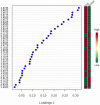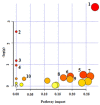Xanthatin Induces Leishmanicidal Activity by Affecting Carbon Metabolism in Amastigotes
- PMID: 35194428
- PMCID: PMC8842595
- DOI: 10.22037/ijpr.2021.114937.15122
Xanthatin Induces Leishmanicidal Activity by Affecting Carbon Metabolism in Amastigotes
Abstract
Cutaneous leishmaniasis is caused by protozoa of the genus Leishmania and spread by sandflies. The standard therapy for this ailment is the first-line medication of pentavalent antimonial and the second drug line of pentamidine amphotericin B. All are practiced over the years and exhibit adverse toxicity effects. Herbal product-derived medicine is a promising potential source for treating parasitic diseases. Xanthatin, a xanthanolide sesquiterpene lactone, is isolated from Xanthium strumarium L. treats several ailments in many countries. In the present study, we investigated the leishmanicidal activity of the xanthatin by using a metabolomics-based analysis in J774 macrophages and amastigotes phases in Leishmania major. Xanthatin was isolated and identified by NMR spectroscopy. Macrophage toxicity of xanthatin performed by MTT assay. Macrophages infected by the L. major's promastigote stationary phase, the infection rate (IR), and multiplication index (MI) were calculated. Axenic amastigotes were treated with xanthatin. Cell quenching and metabolite extraction were performed, and the metabolome profile was analyzed with NMR spectroscopy. Outliers were classified by using multivariate statistical analysis software, and relevant metabolites and pathways were worked out. The xanthatin IC50 rate defined 0.75 µg/mL base on macrophages viability and also in-vitro activity of xanthatin on amastigotes showed the best leishmanicidal activity in IR and MI values of 53% and 62.5%, respectively. Xanthatin altered amino sugars and nucleotide sugars metabolism, starch and sucrose metabolism, cyanoamino acid, and galactose metabolism. Our finding revealed that the main target of xanthatin is carbon metabolism, which is an essential step for amastigotes virulence.
Keywords: 1HNMR Spectroscopy; Leishmania major; Leishmania metabolome; Metabolomics; Xanthatin.
Conflict of interest statement
The authors have no conflict of interest to declare.
Figures





References
-
- World Health Organization annual report. Leishmaniasis fact sheet . Published by WHO; 2020.
-
- Husein-ElAhmed H, Gieler U, Steinhoff M. Evidence supporting the enhanced efficacy of pentavalent antimonials with adjuvant therapy for cutaneous leishmaniasis: a systematic review and meta-analysis. J. Eur. Acad. Dermatol. Venereol. . 2020;34:2216–28. - PubMed
-
- Li Y, Chen F, Li Z, Li C, Zhang Y. Identification and Functional Characterization of Sesquiterpene Synthases from Xanthium strumarium. Plant and Cell Physiol. . 2016;57:630–41. - PubMed
-
- Fan L, Zhang C, Ai L, Wang L, Li L, Fan W, Li R, He L, Wu C, Huang Y. Traditional uses, botany, phytochemistry, pharmacology, separation and analysis technologies of Euonymus alatus (Thunb) Siebold: A comprehensive review. J. Ethnopharmacol. . 2020;259:112942. - PubMed
LinkOut - more resources
Full Text Sources
